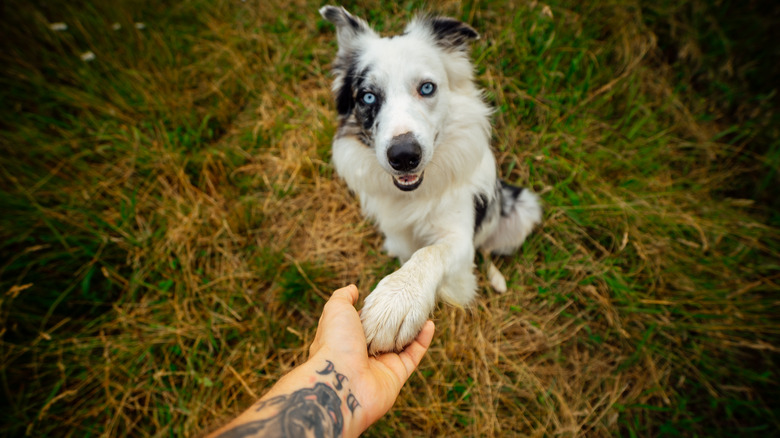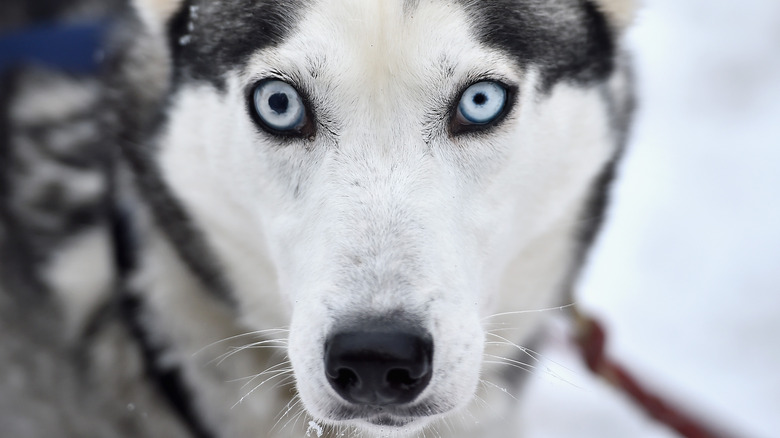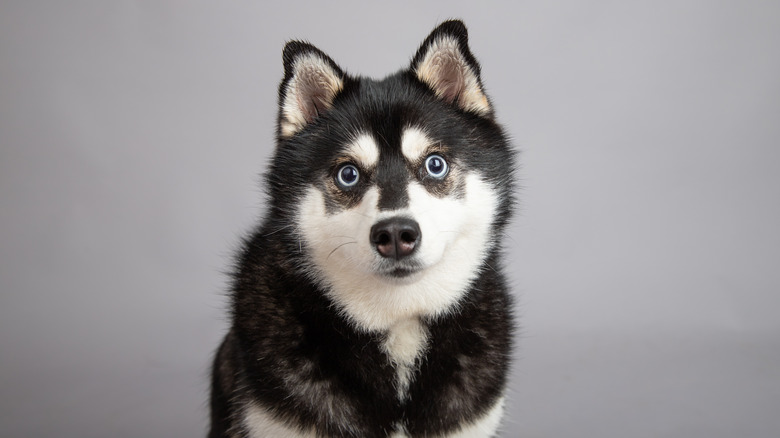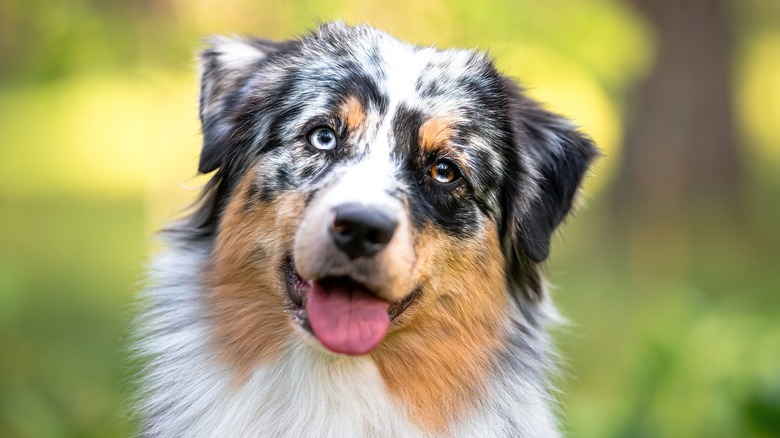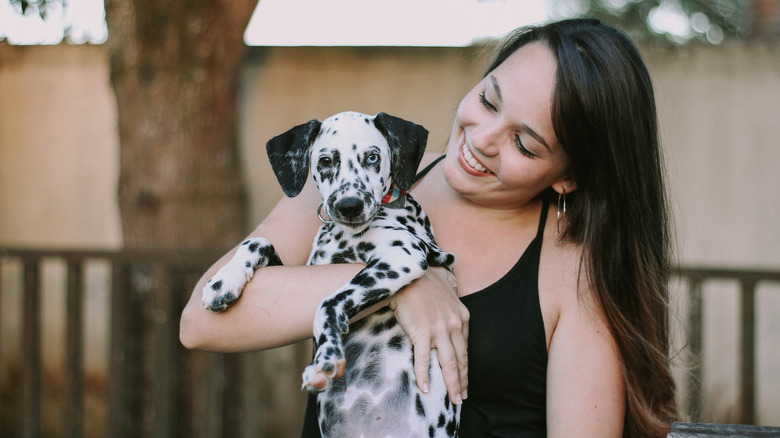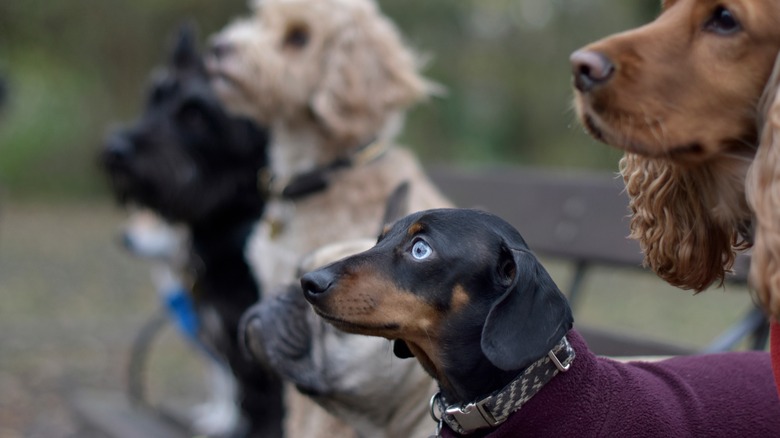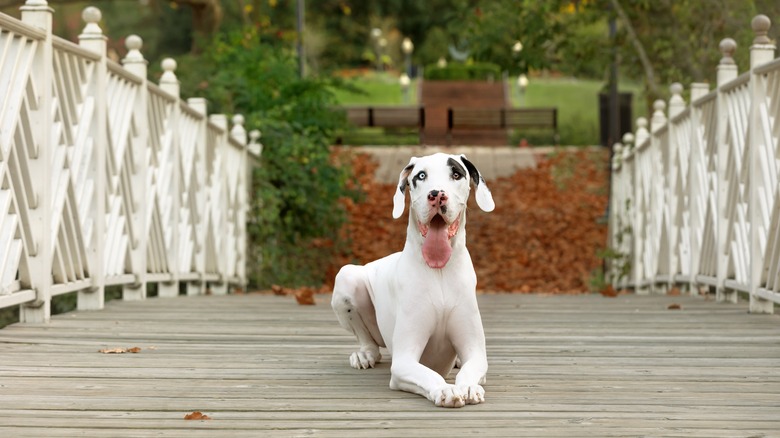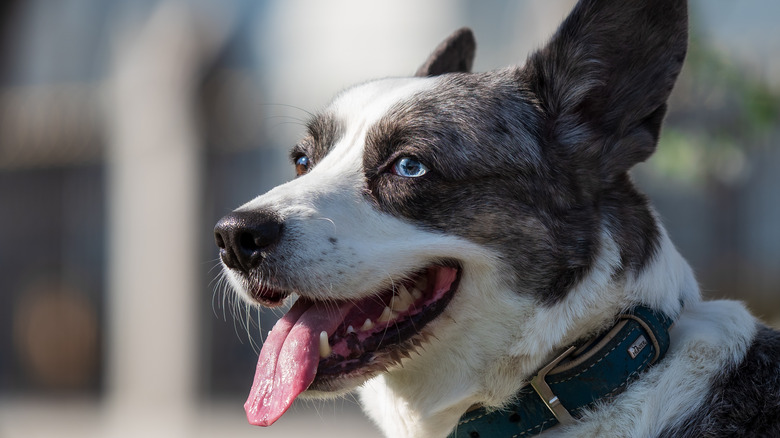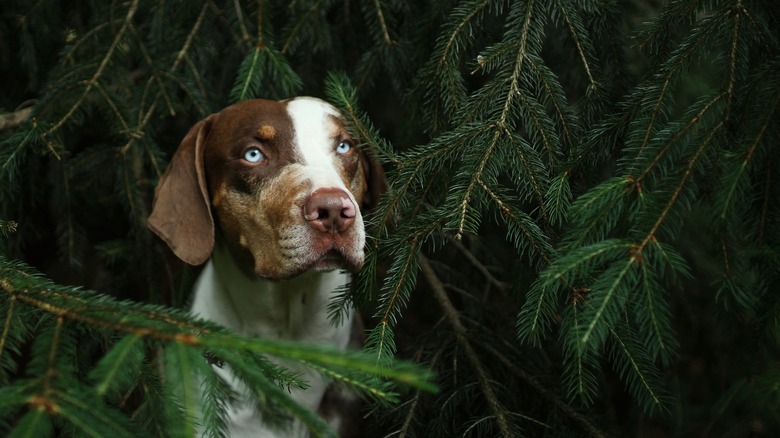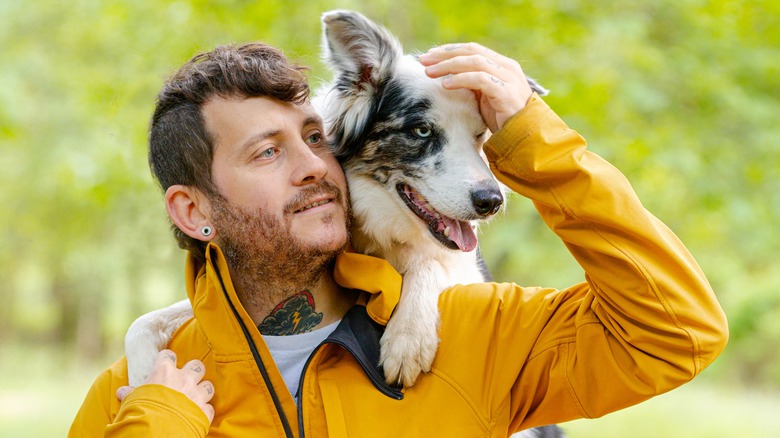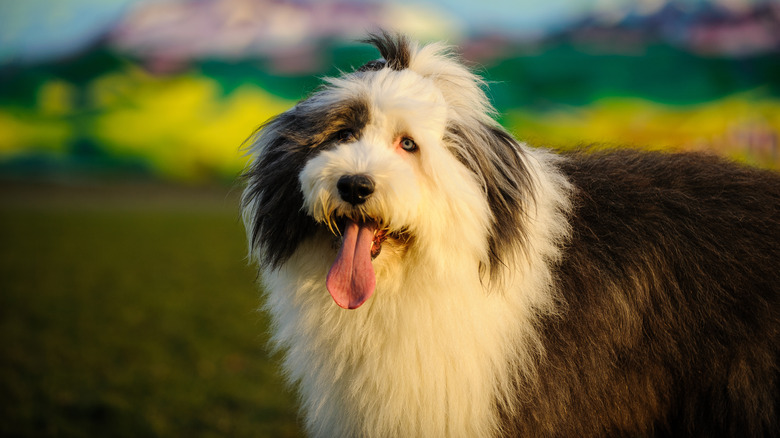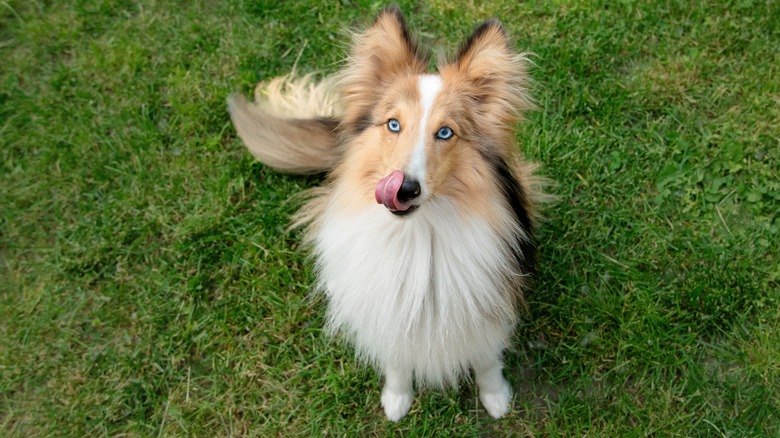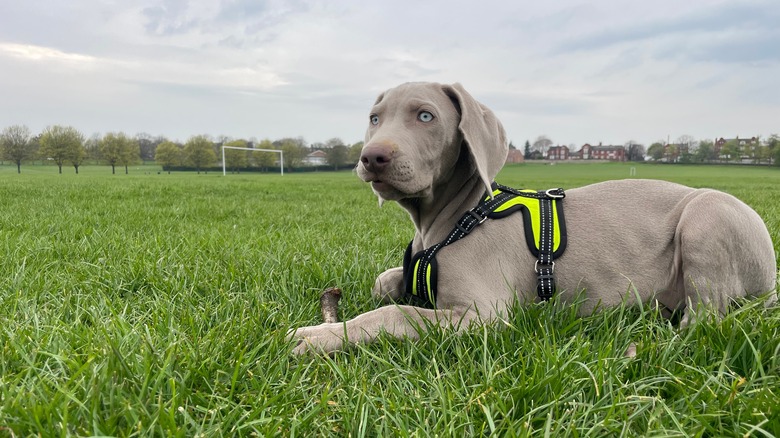13 Dog Breeds With Beautiful Blue Eyes
It's a common fact that all puppies are born with blue eyes. It isn't until they're three or four weeks old that those irises start darkening to their final adult color, which is usually some shade of brown. However, on rare occasions, you might encounter a fully grown dog with one or more blue eyes.
Blue eyes in adult dogs is often associated with merle patterning. This refers to irregular patches of diluted pigment in an otherwise fully pigmented coat. If a dog looks like it has camo patterning, it's probably a merle. Moreover, according to research published by Louisiana State University, there is a strong statistical correlation between blue eyes and deafness in animals. Those two factors line up often enough that veterinarians discourage breeding two merle animals, as their offspring are much more likely to have impaired vision or hearing.
Of course, not all blue-eyed dogs are deaf, and not all dogs who are deaf have blue eyes. In certain cases, blue eyes are simply the result of a genetic mutation, regardless of fur appearance or their hearing ability. And, much like in other species, there are certain breeds who are more likely to have them than others.
1. Siberian husky
Perhaps the most iconic of the (potentially) blue-eyed dog breeds is the Siberian husky. One study published in PLOS GENETICS indicates that huskies in particular tend to have bright blue eyes more often than other breeds due to a particular mutation on the ALX4 gene. Although the Siberian husky is the only husky breed acknowledged by the American Kennel Club, there are several other varieties of husky. The average Siberian husky weighs between 35 and 60 pounds, and has a life expectancy of about 12 to 14 years.
Beyond their striking appearance, the husky is known for being incredibly friendly, social, and vocal. This can make them a great companion for families as long as you don't mind their notorious habit of "singing" and "talking" (vocalizing). Huskies are also very intelligent; they require lots of vigorous exercise and mental stimulation, and their thick coats require frequent brushing.
If you're an athletic family looking for an equally athletic dog to accompany you on adventures, a husky might be the perfect choice. That said, every breed has their potential downsides. For huskies, those include the tendency to roam if allowed. Further, the American Kennel Club warns that huskies often have such a strong drive to chase small animals, which means they're probably not an ideal choice for families with cats or other small pets. Having lots of secure room for your husky to run out their energy — without endangering other animals or themselves — is really important if you're thinking of bringing one home.
2. Alaskan Klee Kai
You might think of the Alaskan Klee Kai as a miniature Siberian husky. Indeed, they display many of the same traits as the snow dog in a more petite package, including a tendency to have blue eyes. Per PetMD, it's believed all Alaskan Klee Kais descended from one particularly small husky named "Curious." That said, because the Klee Kai was bred to be more of a house dog and companion, they're not as strongly driven to work as the husky is.
Like the Siberian husky, though, the Alaskan Klee Kai is intelligent, friendly, and vocal, although they might not be as off-the-charts social as full-size huskies. The Klee Kai does best when it gets lots of vigorous exercise and mental stimulation to help it lead with the best aspects of its husky-like personality. If you find that your Klee Kai has taken up husky-level "singing" and vocalizing, it may need your help to stay more engaged.
You can expect the average adult Alaskan Klee Kai to be half the size of a Siberian husky or even a little smaller. They average between 16 and 25 pounds when fully grown. The Klee Kai's life expectancy is also a little longer than a husky's, averaging about 13 to 16 years.
3. Australian shepherd (Aussie shepherd)
Like many potentially blue-eyed dogs, the Australian Shepherd may have two identical blue eyes in maturity, or a single blue and brown eye. The findings in the previously mentioned 2018 PLOS study found that like the Siberian husky, this breed is likely to carry the ALX4 chromosome mutation.
Beyond their blue eyes, the other memorable feature of this breed is its coat. These dogs are shedding champions that require frequent brushing and grooming.They also need serious mental and physical exertion. Although they are capable of adapting to various living situations when those needs are met, an Australian shepherd that doesn't have any other "job" might entertain itself by herding kids and other pets. You may have seen iconic photos and videos of Aussie shepherds working as service dogs or search and rescue dogs: This is thanks to their extreme intelligence and athleticism, which make them very trainable. However, it can present a challenge for owners who aren't prepared to keep them "employed" with lots of exercise and entertainment.
Early socialization is critically important to keep them from translating their herding instinct into unwanted chasing behaviors. Aussie shepherds can get pretty big, too, averaging a full-grown body weight of 40 to 65 pounds, and a life expectancy of 12 to 15 years.
4. Dalmatian
If you're athletic and want a blue-eyed dog you can really bond with, the Dalmatian is your answer. These spotted canines are high energy in a bottle, and often associated with firefighters because they were bred to run alongside horse-drawn fire engines. Dalmatians are also known to be very intelligent and have very good memories, which makes them very trainable.
As loving as Dalmatians are with their human families, they absolutely have to get all that energy out somehow. Because of this, they might be too much for young children or other pets. It's important to socialize your Dalmatian to help them remain calm, confident and reliable in every possible situation.
Dalmatians are large dogs, typically ranging from 45 to 70 pounds in weight, so it's worth making sure you have enough space to accommodate a part-time ball of energy of that size. Their average life expectancy is 11 to 13 years.
5. Dachshund
Typically, dachshunds have light brown or green eyes, but on rare occasions, their eye color can be blue.Their hair, meanwhile, can have even more variety. Although the most iconic image of a dachshund features a smooth brown-and-black coat, the breed also comes in long- and wire-haired coats ranging from tan to black.
Dachshunds may be small, but these clever, courageous hounds are loyal and affectionate. That trait, combined with their "big dog" bark in a small dog's body and willingness to take on animals much larger than themselves, all make them surprisingly good guard dogs. What about potential bad habits? Nobody is perfect, not even the dachshund: They aren't the most trainable dog, and they have a tendency to be very independent and to dig holes — neither of which is really surprising, since they were originally bred for hunting badgers out of their dens. The dachshund's best family may be one that can give them lots of attention and not leave them alone for long periods, as they may be prone to separation anxiety.
Full-grown dachshunds typically average 16 to 32 pounds in weight, although miniature dachshunds usually top out at no more than 11 pounds. You can expect full-size or mini dachshunds to life for about 12 to 16 years.
6. Great Dane
The enormous — and enormously loving — Great Dane is an alert, endlessly loyal pet who sometimes has one or two blue eyes. These gentle giants have a reputation for being patient and generally easy to train, although some individuals can be stubborn.
When it comes to having a Great Dane, sometimes the elephant in the room is ... well, sometimes the elephant in the room is a Great Dane. As adorable as the puppies may be, and as charming (or well-protected) as the idea of living with a gentle giant like this may be, they can easily weigh as much as a full-grown human.
A dog that big requires a lot of space, and a lot of food; a fully grown Great Dane can weigh anywhere from 110 to 175 pounds, and live for seven to 10 years. So before you bring home a Great Dane, blue eyes or not, it's well worth calculating out what sort of dog food costs you'll have to include in your budget, and whether you really have enough space for a dog that will be taller than most humans when it stands on its hind legs.
7. Cardigan Welsh corgi
Although blue eyes can occur in both Cardigan and Pembroke Welsh corgis, they're only permitted in the breed standard for the Cardigan Welsh Corgi, and only then if said corgi has blue merle coloring. A blue-eyed Pembroke corgi is considered unacceptable within the breed standard, so, they are less likely to be bred. These medium-sized dogs typically weigh from 25 to 38 pounds, and live an average of 12 to 15 years.
Blue-eyed or not, corgis are sweet, congenial dogs that were originally bred for herding cattle. They're surprisingly athletic, given their low-slung build, and thrive with plentiful exercise and mental stimulation. They're very trainable, and if your corgi is well-socialized it's likely to be especially good with children, and to get along with other pets.
Not sure how to tell if you're looking at a Cardigan Welsh corgi or a Pembroke Welsh corgi? The big giveaway is their tail, as only Cardigan Welsh corgis have them. Pembroke Welsh corgis, like the ones famously owned by the late Queen Elizabeth II, do not have tails.
8. Catahoula leopard dog
Catahoula leopard dogs are known for their striking eyes. Because there is no standard eye color for the breed, their iris shades can range widely from blue to green, gold, or brown. However, the National Association of Louisiana Catahoulas states that a glass (or very light-colored, verging on white) eye is preferred, so perhaps it's no surprise that blue eyes — which represent a lack of pigment in the iris — are common among this breed.
Catahoulas are strong-willed, independent herding dogs, with a considerable amount of energy. For this reason, they may not be the best choice for first-time dog owners. Even seasoned dog people who don't have a job for their Catahoula leopard dog may find themselves outmatched: This dog's independent and territorial nature can run roughshod over anyone who isn't ready to provide firm, appropriate training and handling for the entirety of its 10- to 14-year lifespan.
Interestingly, the Catahoula is the only dog breed to originate in the state of Louisiana. This resulted from a cross between Indigenous dogs in the area with hounds and mastiffs brought by Spanish explorers, then with French hounds. All together, this blend of hunting and working dogs created the Catahoula, which averages a body weight of 50 to 95 pounds.
9. Border collie
If you've ever seen a video of a border collie crouched low to the ground and staring intensely at a herd animal, you're probably familiar with the breed's famous "eye." Although that "eye" is a figure of speech, it's understandable how other animals would be intimidated, or at least captivated by them; especially when they come in a bright blue shade.
Border collies historically thrived in their duties of sheep-herding in the border regions of Scotland and England, but they are so incredibly intelligent that the breed still excels at almost any task given to them today. This includes dog sports like agility, flyball, and tracking, as well as demanding jobs like search and rescue, or clearing airport runways of wildlife. In 2019, one border collie was even acknowledged as "the smartest dog in the world," as she had proven that she understood more than 1,000 English words.
As you might imagine, a dog with this much intelligence, athleticism, and overall intensity needs an outlet for all that energy. They simply do not make good couch potatoes. But if you have a job for this dog, and the time and energy required to help them learn it, you could be looking at the start of a great team — helped by the fact that these brilliant dogs are relatively long-lived, with an average life expectancy of 12 to 15 years.
10. Pit bull
Sorting through the breed standards for pit bulls gets a little confusing once you realize that the dog colloquially known as the pit bull refers to the Staffordshire bull terrier, American Staffordshire Terrier, American pit bull terrier, or any mix of those breeds. Of these dogs, only the American pit bull terrier breed standards mention blue eyes, and even then it is considered a fault. So while blue eyes can happen in pit bulls, especially as a mutation, they're not very common.
Per the American Kennel Club breed standard for the Staffordshire bull terrier and the United Kennel Club standard for the American pit bull terrier, both dogs tend to display some inherent level of aggression toward other dogs. That tendency can creep into other situations, too, so careful socialization and training is critically important for any pit bull breed to help prevent heartbreaking accidents.
Given the different breeds that may go into a "pitty," it's not a big surprise that their body size can vary quite a bit: A full-grown pit bull may weigh anywhere from 24 to 70 pounds. On average, the pitty breeds tent to live for 12 to 16 years.
11. Old English sheepdog
Do Old English Sheepdogs even have eyes? It's hard to be sure until they get a good haircut or end up in one of those cute little topknots. But rumor has it that breed standards allow for one or two blue eyes.
Of course, the Old English Sheepdog is better known for its profuse, shaggy coat. So if you're thinking of bringing one home, it's best to have an action plan in place to deal with all that fur. Although they have a shuffling gait when at rest, there's a surprisingly nimble, athletic body contained within those 60 to 100 pounds of fluff. As such, these dogs also need a good-sized yard to frolic in before coming back indoors for shelter.
As long as you're prepared to deal with its grooming and exercise needs, the Old English Sheepdog is a great house pet. The breed tends to be sweet, patient, alert and intelligent: All the qualities needed in a good family playmate or watchdog. Most Old English sheepdogs will live to be10 to 12 years old.
12. Shetland sheepdog (Sheltie)
These wonderfully intelligent little herding dogs look much like their bigger cousin, the collie; in fact, they were originally known as the Shetland collie. Both breeds are from Scotland, although the Shetland sheepdog, or Sheltie, hails from a more remote, rugged part of the country: the Shetland Islands at the very northernmost point of Scotland. The rugged nature of those islands would have made the Sheltie's small size an advantage, simply because it didn't need to eat as much as a large dog.
The Sheltie's high intelligence, obedient nature and urge to work make them stellar competitors in dog sports such as obedience, agility and herding. They also make good household watchdogs, thanks to their fondness for family, tendency to bark, and habit of being initially reserved to strangers.
Shetland sheepdogs can have one or two blue eyes, although breed standards only allow for blue eyes in Shelties with merle coloring. That doesn't mean Shelties of other coat colors can't have blue eyes, too. However, they are less likely to be bred for show purposes. The average Sheltie weighs between 15 and 25 pounds and can live as long as 12 to 14-years-old.
13. Weimaraner
All Weimaraners are born with piercing blue eyes. Perhaps it's not so surprising that Grace Kelly, the famous blue-eyed icon of Hollywood elegance, owned one herself. Even after their eyes shift to their adult color, the Weimaraner's irises tend to contain light shades like amber or gray. They can also stay a lovely blue-gray color for their entire 10 to 13 year life span.
In addition to having a striking appearance, the adult Weimaraner is a sleek, athletic dog known for its wonderful attitude. As long as you tend to their need for lots of exercise and desire to be a well-integrated part of the family, you can expect them to be a calm presence in your home life. A well-socialized and exercised Weimaraner is usually great with kids, and their short, sleek coat is much easier to groom than many other blue-eyed dogs. They are considered a large size dog, weighing between 55 and 90 pounds.
Weimaraners were originally bred to be hunting dogs, and the breed has been nicknamed "the gray ghost" for its stealthy, catlike hunting style. At same time, they can be stinky, gray ghosts, thanks to an innate urge to roll in any odiferous thing they can find to disguise their scent.
